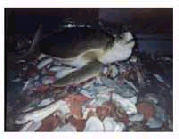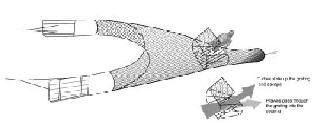|
Monitoring the catch of turtles in the Northern Prawn Fishery
July 2002
Non-technical summary
Bycatch, the catch of non-target species, is a significant issue in many of the world’s fisheries. Sea turtles are of particular concern given their endangered status and the considerable numbers caught, and occasionally killed, worldwide in commercial fishery operations. Trawl fisheries, in particular, are recognised as discarding the greatest amount of bycatch compared to other commercial fishing methods. An estimated 37.2% of the total global discards have been attributed to trawlers (Alverson et al., 1994). In addition, trawling operations have been held responsible for more sea turtle deaths than any other human-related factor (Bisong, 2000). A project conducted in 1989 and 1990 estimated that 5 000 to 6 000 turtles were caught by NPF trawlers annually, with a mortality rate of up to 39% (Poiner and Harris, 1996).
For many years Turtle Excluder Devices (TEDs) have been hailed as the solution to sea turtle mortality from trawl fisheries. TEDs – devices sewn into trawl nets that selectively remove large organisms, such as turtles, while allowing the smaller target species to be caught – have been introduced in many trawl fisheries worldwide. In 2000, the use of TEDs was made mandatory in the NPF.
The issue of sea turtle bycatch in trawl fisheries is important given the 1996 United States import embargo on wild caught prawns that were taken in a fishery without adequate turtle bycatch management practices, the objectives of the Draft Australian Recovery Plan for Marine Turtles and the requirement of the Australian Environment Protection and Biodiversity Conservation Act (EPBC Act) for Commonwealth fisheries to become ecologically sustainable.
This study evaluates the effectiveness of TEDs in reducing sea turtle bycatch in the NPF. It is based on data collected by volunteer fishers from the fleet and verified using independent scientific observers. The study demonstrates that TEDs substantially reduce capture of sea turtles during trawling activities in the NPF. Prior to the use of TEDs in NPF trawl nets, an estimated 5 000 sea turtles were caught annually by the trawl fleet. Since TEDs were installed the catch of sea turtles is estimated to have fallen to possibly fewer than 200 turtles per year. In addition, prior to the use of TEDs turtle mortality is estimated to have decreased from close to 40% in earlier years to around 22% in recent years. This may be attributed to the improvement in turtle handling techniques adopted by the fishers in the fleet. The turtles that continue to be captured while TEDs are used in the fishing gear are primarily taken during the winching-up of the nets, a late stage in the fishing operation. These sea turtles are presumed to survive due to the short time they are in the trawl and, consequently, since the introduction of TEDs few turtles are expected to die as a result of capture in trawl nets in the NPF.
The use of fishers to monitor the catch of rare species was demonstrated to be effective in terms of cost and validity of results. Appropriate timing was considered to be a fundamental aspect to the success of the project. In this case the timing was right in that TEDs were becoming mandatory in the NPF in 2000, so the research were unlikely to impact negatively on fishing operations.
While TEDs have been shown to be effective in reducing deaths of sea turtles as a result of trawling operations, there is the need to address sea turtle mortality from capture in other commercial fishing gears. Substantial numbers of turtles die during longline, pound net, gill net, purse seine and pot trapping operations (Crouse, 1984; Oravetz, 1999). Mortality from these operations is reported to be much lower than from trawl operations, however, it may still be contributing to the decline of sea turtle populations.
Turtle Excluder (or Exclusion) Device
TED is the acronym commonly used for Turtle Excluder (or Exclusion) Device, but can also stand for Trawl Exclusion Device, Trawl Efficiency Device, Trash Eradication Device or Trash Elimination Device (Andrew and Pepperell, 1992). For many years TEDs have been considered to be the solution to sea turtle bycatch. Designed to allow prawn trawling to continue while protecting sea turtles, TEDs are sewn into trawl nets to separate large unwanted animals, generally sea turtles but also other large organisms like sharks and rays, from the smaller target species, generally prawns or fish. They enable large animals to exit the net before reaching the cod-end. There are many designs, although most commonly they consist of a grid (or grating) that directs the turtle towards a hole in the net.
Click here to download a full copy of “The Monitoring the catch of turtles in the Northern Prawn Fishery” in pdf format - (1.2Mb)
Top
|

